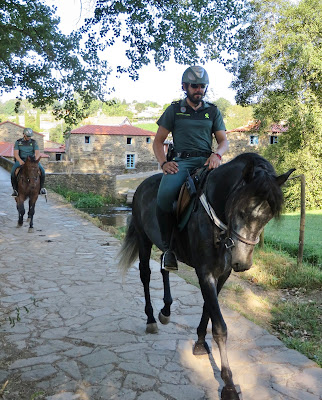From Melide there were three more days of walking to reach Santiago. In Melide I was up at 6:00, out of the albergue by 7:00. Many pilgrims had left earlier and most likely were walking a greater distance than what I planned. My destination that night was Arzua, and I'd made a reservation at a private albergue so no concerns about getting a bed.
This day, July 25th, was St. James' Feast Day, a holiday in Galicia that honors the patron saint of Spain. The day's celebration includes special church services, music concerts, and dance performances in towns across the region. The city of Santiago holds special events during festival week, including a spectacular fireworks display by the cathedral.
This day, July 25th, was St. James' Feast Day, a holiday in Galicia that honors the patron saint of Spain. The day's celebration includes special church services, music concerts, and dance performances in towns across the region. The city of Santiago holds special events during festival week, including a spectacular fireworks display by the cathedral.
New stone markers, such as the one shown, have recently replaced the more charming older markers in Galicia. Last year they were just starting to pull the old ones out of the ground in preparation for the new models.
The sign didn't say where a "Donkey stamp" was available (?)
"The Little Oasis" snack stand wasn't open yet.
Another picnic area had a sign welcoming walkers to the county of Arzua. The sign includes "Pelerin," the Galician pilgrim mascot created in 1993 for the Holy Year.
Little Red Riding Hood kept an eye on walkers as they trekked by her yard.
The "Paracuellos to Santiago" peregrinas posed after breakfast at Albergue Santiago bar in Castaneda. Their enthusiasm and smiles were infectious!
Castaneda was the place where limestone rocks for building Santiago's cathedral were deposited by medieval pilgrims who transported them from Triacastela. The rocks were then fired there to produce a lime mortar.
A board inside the bar posted thank you notes from walkers who had stayed at the albergue, including "Bob and Debbie" from Chicago who appreciated the hospitality.
A few pilgrims I passed on the trail were walking in the opposite direction, perhaps returning from Santiago. In the Middle Ages, this sight would have been common.
In Ribadiso da Baixo the Guardia Civil rode by -- I'd seen them on horseback several times along the journey. The Guard patrols rural areas and is Spain's oldest law enforcement agency, established in 1844.
Large hay rolls are drying in fields this time of year. These were already in storage.
The Albergue da Fonte in Arzua was located along the Road at the end of the town's old section. My room included a quaint stone wall on one side.
Locals chatted in the shade across the street.
Walkers' laundry drying at the albergue
People relaxed in Arzua's central plaza.
Most businesses were closed because of the celebration. A few bars/restaurants remained open, and in one of them I enjoyed a queso y tomate bocadillo with a Kas limon. The cheese in my sandwich probably wasn't the town's specialty, Ulloa, with a soft & creamy texture. In March, Arzua even hosts a cheese festival.
In the evening I attended Iglesia de Santiago's Mass (in Spanish) to honor St. James. During the service, the priest asked where pilgrims were from -- there was an assortment of countries mentioned along with a handful of us from the U.S. At the end, he called walkers upfront and gave a blessing in both Spanish & English.
Iglesia de Santiago was rebuilt in 1955 and includes 2 St. James' sculptures.
This one looked to be from the Baroque period or later.
This one looked to be from the Baroque period or later.
Some of the Spanish student groups I'd seen walking were at the church and participated in the service. The last segment of Camino Frances, from Sarria to Santiago, typically has lots of student groups who walk this stretch. During festival week there are probably more than normal.
Afterwards I walked back to the albergue and tucked in for the night.
It was nice to have been in Galicia for St. James' Day!
It was nice to have been in Galicia for St. James' Day!





























No comments:
Post a Comment